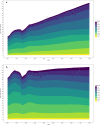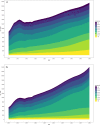The projected volume of primary and revision total knee arthroplasty will place an immense burden on future health care systems over the next 30 years
- PMID: 32671435
- PMCID: PMC7362328
- DOI: 10.1007/s00167-020-06154-7
The projected volume of primary and revision total knee arthroplasty will place an immense burden on future health care systems over the next 30 years
Abstract
Purpose: Total knee arthroplasty (TKA) rates have increased substantially in the recent decades worldwide, with Germany being one of the leading countries in the prevalence of TKA. The aim of this study was to provide an overview of treatment changes during the last decade and to project the expected burden of primary and revision TKA (rTKA) for the next 30 years.
Methods: Comprehensive nationwide data from Germany was used to quantify primary and revision TKA rates as a function of age and gender. Projections were performed with use of a Poisson regression models and a combination of exponential smoothing and autoregressive integrated moving average models on historical procedure rates in relation to official population projections from 2020 to 2050.
Results: The incidence rate of primary TKAs is projected to increase by around 43% to 299 per 100,000 inhabitants [95% CI 231-368], leading to a projected total number of 225,957 primary TKAs in 2050 (95% CI 178,804-276,442). This increase has been related to a growing number of TKA performed in male patients, with the highest increase modelled in patients between 50 and 65 years of age. At the same time, the annual total number of revision procedures is forecast to increase even more rapidly by almost 90%, accounting for 47,313 (95% CI 15,741-78,885; IR = 62.7 per 100,000, 95% CI 20.8-104.5) procedures by 2050. Those numbers are primarily associated with a rising number of rTKAs secondary to periprosthetic joint infection (PJI).
Conclusions: Using this country- specific forecast approach, a rising number of primary TKA and an even more rapidly growing number of rTKA, especially for PJI, has been projected until 2050, which will inevitably provide a huge challenge for the future health care system. As many other industrialized nations will face similar demographic and procedure-specific developments, these forecasts should be alarming for many health care systems worldwide and emphasize the tremendous need for an appropriate financial and human resource management in the future.
Level of evidence: Level III, prognostic study, economic and decision analysis.
Keywords: Arthroplasty; Germany; Projection model; Revision knee arthroplasty; Total knee replacement.
© 2020. European Society of Sports Traumatology, Knee Surgery, Arthroscopy (ESSKA).
Conflict of interest statement
None of the authors, their immediate families, and any research foundation with which they are affiliated received any financial payments or other benefits from any commercial entity related to the subject of this article. Alexander Klug or any member of his or her immediate family, has no funding or commercial associations (e.g., consultancies, stock ownership, equity interest, patent/licensing arrangements, etc.) that might pose a conflict of interest in connection with the submitted article. Manuel Weißenberger or any member of his or her immediate family, has no funding or commercial associations (e.g., consultancies, stock ownership, equity interest, patent/licensing arrangements, etc.) that might pose a conflict of interest in connection with the submitted article. Reinhard Hoffmann or any member of his or her immediate family, has no funding or commercial associations (e.g., consultancies, stock ownership, equity interest, patent/licensing arrangements, etc.) that might pose a conflict of interest in connection with the submitted article. Yves Gramlich or any member of his or her immediate family, has no funding or commercial associations (e.g., consultancies, stock ownership, equity interest, patent/licensing arrangements, etc.) that might pose a conflict of interest in connection with the submitted article. Philipp Drees or any member of his or her immediate family, has no funding or commercial associations (e.g., consultancies, stock ownership, equity interest, patent/licensing arrangements, etc.) that might pose a conflict of interest in connection with the submitted article. Maximilian Rudert or any member of his or her immediate family, has no funding or commercial associations (e.g., consultancies, stock ownership, equity interest, patent/licensing arrangements, etc.) that might pose a conflict of interest in connection with the submitted article. KarlPhilipp Kutzner or any member of his or her immediate family, has no funding or commercial associations (e.g., consultancies, stock ownership, equity interest, patent/licensing arrangements, etc.) that might pose a conflict of interest in connection with the submitted article.
Figures






References
-
- Bozdogan H. Model selection and Akaike's Information Criterion (AIC): the general theory and its analytical extensions. Psychometrika. 1987;52:345–370. doi: 10.1007/BF02294361. - DOI
MeSH terms
LinkOut - more resources
Full Text Sources
Medical
Research Materials

